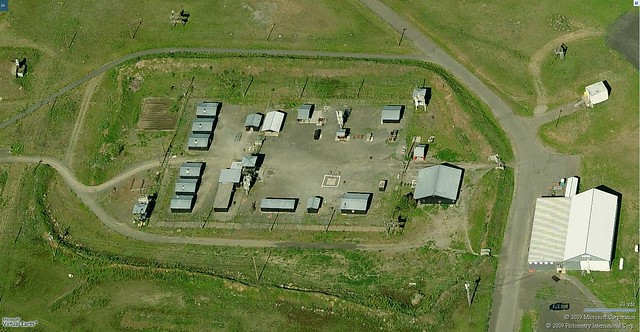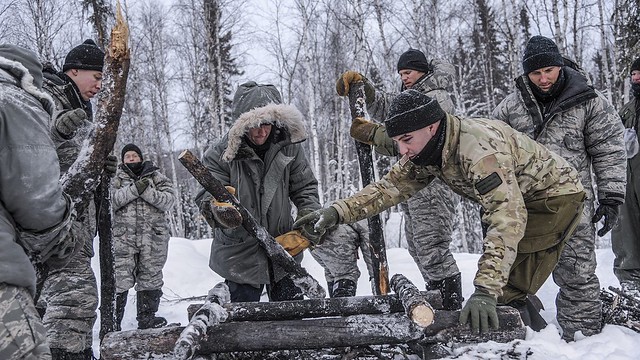Today they call it SERE, for Survival Evasion Resistance Escape. When I went through the training in the mid-1970s, it was called Survival School.
What prompted the memory was last night’s Netflix rental, the epic survival movie The Way Back, a story about escapees from a Siberian prison camp who trekked 4,000 miles across Russia, Mongolia, and Tibet to reach safety in India. In the movie, two characters hallucinate in the darkness. Been there, done that, I told my daughter Polly, and she turned around and repeated my story on Facebook, so now I feel committed to share it with you.
In the 1970s, all USAF aircrews — pilots, navigators, flight engineers, gunners, loadmasters, pararescue jumpers — had to go through survival school at Fairchild AFB near Spokane, Washington. The course lasted five days. You spent a day in academics, then were issued survival gear similar to what you might have on board an aircraft. The field training consisted of two days in a POW camp, then a two-day cross-country trek through forests and mountains, using your survival gear and academic training to live off the land, navigating your way to an area where resistance forces might find you and help repatriate you to friendly forces. It was all quite realistic, and hard.
My hallucinations happened in the POW camp. The first night, after academics and survival equipment issue, we were given a few hours to ourselves in the school barracks. We all smoked in those days. Knowing cigarettes would be in short supply the next four days, we stayed up late tearing open seams in our survival clothing, sticking cigarettes and matches inside, then sewing the seams back up. About two in the morning they rounded us up and trucked us into the woods, where we were immediately captured by enemy forces dressed as Viet Cong, hooded and tied together, and marched to a POW camp. Once there we were stripped and taken, wearing only underwear, to our cells.
Two of my hallucinations happened in a box. They stuffed us, still hooded, into telephone booth-sized boxes with adjustable floors so that whether you were tall or short, you’d have to stoop to fit inside. You had a can on the floor to pee in, and you couldn’t squat down because the guards would come by every few minutes to look at you through peepholes and scream at you. It was pitch black inside. After a few hours, I saw what looked like a shelf set into the wall in front of my face. There was a jar of strawberry jam on the shelf. Every time I reached for it my hand would hit the wall. I knew it was a hallucination, but I kept reaching for the jam.
During our box time, which probably lasted about 8 hours but felt like 24, the guards would pull two or three of us at at time out for interrogation sessions and simulated torture exercises. But after every session we were stuffed back into our boxes. The entire time, a loud tape of Asian-style music played the same horrible screeching songs over and over again. Back in the box, I started to see what looked like a ship’s bunk bed on the wall, right about waist level. As I looked, the bunk became clearer. There was a pillow, a wool blanket, even a book. There was never a more inviting bed. I hiked up my leg to get in and bashed my knee on the wall. After a while I tried it again. And again.
When our box, interrogation, and torture sessions were over, they gave us back our clothing and marched us into the POW camp yard. It was still pitch black, since it was now the following night. We all started frantically searching our seams for cigarettes, but the survival school instructors had been there before us and taken almost all of them. I found half a cigarette in a shoulder seam and about five of us huddled around in a dark area between spotlight beams to share it. While I was looking through the barbed wire fence into the open country beyond I saw my third hallucination, a white and grey badger-looking animal moving around on some nearby hillocks. I can’t remember for sure, but I think we were allowed to sleep a few hours before morning.
The next day we were trucked into the woods up on the side of a nearby mountain, where we started our overland trek. The idea was to navigate to a friendly area, a place where local resisters were supposed to have a camp. Along the way we practiced building different kinds of survival shelters, lighting fires without matches, using compasses, identifying and eating edible roots, catching animals for food with snare wires, and evading capture by enemy forces.
The two-day trek was actually great fun — if you didn’t mind skinning and eating the occasional gopher — and when we were finally found and taken in by resistance forces, we celebrated by making a great pot of stew over a roaring fire in the resistance camp. By this time almost everyone had something edible picked up on the trek — tubers, wild onions, leftover chunks of gopher — and it all went into the pot. The resistance fighters supplied the broth, which was basically tomato sauce. Best stew ever; none of us could get enough. Did I mention this was in January and we’d been freezing and starving for four days?
Finally back to the barracks at Fairchild, warm showers and clean clothes, a bus to the airport, back to the real world. It was a hoot, and damn good training besides.
Oh, back at the barracks I bumped into one of the guys I’d shared my stub of a cigarette with. He asked me if I’d seen the badger too.


Hmmmmm. Just what was in that cigarette?
Before I ever met you, I knew a guy who hiked. Serious hiking. One summer he hiked from the Oregon border through wilderness country, down to my apt in Sacramento. Which is where all the trouble started. He wanted to take me hiking. I said, No way. All my experiences with hiking and camping (including Girl Scout summer camp in the Santa Cruz mountains) had been horrible. He then told me what ALL men have told me (except Greg, of course, who, like my sister, considered camping to be a hotel without room service). He, my friend Igor, not Greg, said those famous words: “Well, you’ve never done it right. Go with me, we’ll do it right, and you’ll love it.” Being that I was young and foolish, I relented. Okay. We’d start with a simple hike. Just a day hike starting at the Stanford Camp Ground by Fallen Leaf Lake (named for its shape), a simple day hike.
So we started off. Now remember, this was one very experienced hiker we’re talking about. So we started off following the trail that, clearly marked, would take us up a winding walk to the top of the hill. And then I said, well, look, there’s this stream, you can see it running down the hill, “WHY DON’T WE CLIMB UP THE STREAM BED?” At this point, this very experienced hiker decided to humor an utter and complete, self-admitted ignoramus, put the map away (which turned out to be out of date anyhow), and we started to climb up the stream bed, which was way more fun than following the trail.
That’s the day I learned about the phrase “false summit.” It looks like the top of the hill, because it’s a cliff that’s HIDING the top of the hill. So we kept climbing. And the lake started to look smaller and smaller. Finally, my friend decided it was time to stop and reconoiter. Over to the southwest was a flat-looking patch where we could sit and have lunch. Unfortunately, between us and that flat-looking patch was about a quarter mile of manzanita, followed by a quarter mile of loose shale. I have never been so scared in my life. Anyhow, we got to the flat-looking patch, had lunch, and my friend checked the map again and came to the conclusion that we were totally and completely lost. He had no idea where the trail was, and the only way down was back the way we had come. At which point I calmly informed him that that was a great idea, he could go back, and when he got back to civilization, he could have them send the rescue helicopter for me, because there was no way I was going back through the loose shale, the manzanita, and then climb back down the streambed. He said, “Have another glass of wine.” And then we went back the way we came. Across the loose shale, struggling through the manzanita, climbing carefully down the streambed, with me shrieking in terror just about every step of the way. Of course, years later, when I took up sailing and learned what real danger was, I never screamed again. And when the tiller came off the boat in my hand, all I said was, “Oh, my God. We’re ten boatlengths from Angel Island.” Followed shortly thereafter by, “What do you mean we can keep sailing using the vise grips?”
In all fairness, the Angel Island experience was followed by the peak experience of my life, when we were out beyond the Golden Gate, coming back in, running before the wind on the most dangerous point of sail, in choppy seas and fair-sized swells, and I singlehandedly brought the 32′ Islander (with a ton of lead in the keel) back in under the bridge. For every moment, I knew exactly where the wind would be before it was there, how to quarter the swells, and how close to keep the point of sail. As the Cherrokees say in “Little Big Man,” I was at the center of the world.
I remember getting you up in the cockpit of an F-15 once, Reliza, and your reaction upon being informed there was no motorized cherry-picker available to return you to earth. And no wine either. You made it back down without a single scream, but it did take a while. Great hiking story, by the way.
And yes, the cockpit of the F15 was really and truly very cool. One of those things I’ll always remember. Until the Alzheimer’s starts eating my brain.